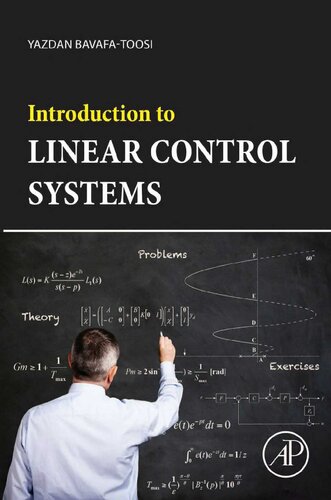Product desciption
Introduction To Linear Control Systems 1st Edition Yazdan Bavafatoosi by Yazdan Bavafa-toosi 9780128127483, 0128127481 instant download after payment.
Introduction to Linear Control Systems is designed as a standard introduction to linear control systems for all those who one way or another deal with control systems. It can be used as a comprehensive up-to-date textbook for a one-semester 3-credit undergraduate course on linear control systems as the first course on this topic at university. This includes the faculties of electrical engineering, mechanical engineering, aerospace engineering, chemical and petroleum engineering, industrial engineering, civil engineering, bio-engineering, economics, mathematics, physics, management and social sciences, etc.The book covers foundations of linear control systems, their raison detre, different types, modelling, representations, computations, stability concepts, tools for time-domain and frequency-domain analysis and synthesis, and fundamental limitations, with an emphasis on frequency-domain methods. Every chapter includes a part on further readings where more advanced topics and pertinent references are introduced for further studies. The presentation is theoretically firm, contemporary, and self-contained. Appendices cover Laplace transform and differential equations, dynamics, MATLAB and SIMULINK, treatise on stability concepts and tools, treatise on Routh-Hurwitz method, random optimization techniques as well as convex and non-convex problems, and sample midterm and endterm exams.The book is divided to the sequel 3 parts plus appendices.PART I: In this part of the book, chapters 1-5, we present foundations of linear control systems. This includes: the introduction to control systems, their raison detre, their different types, modelling of control systems, different methods for their representation and fundamental computations, basic stability concepts and tools for both analysis and design, basic time domain analysis and design details, and the root locus as a stability analysis and synthesis tool.PART II: In this part of the book, Chapters 6-9, we present what is generally referred to as the frequency domain methods. This refers to the experiment of applying a sinusoidal input to the system and studying its output. There are basically three different methods for representation and studying of the data of the aforementioned frequency response experiment: these are the Nyquist plot, the Bode diagram, and the Krohn-Manger-Nichols chart. We study these methods in details. We learn that the output is also a sinusoid with the same frequency but generally with different phase and magnitude. By dividing the output by the input we obtain the so-called sinusoidal or frequency transfer function of the system which is the same as the transfer function when the Laplace variable s is substituted with . Finally we use the Bode diagram for the design process.PART III: In this part, Chapter 10, we introduce some miscellaneous advanced topics under the theme fundamental limitations which should be included in this undergraduate course at least in an introductory level. We make bridges between some seemingly disparate aspects of a control system and theoretically complement the previously studied subjects.Appendices: The bookcontains seven appendices. Appendix A is on the Laplace transform and differential equations. Appendix B is an introduction to dynamics. Appendix C is an introduction to MATLAB, including SIMULINK. Appendix D is a survey on stability concepts and tools. A glossary and road map of the available stability concepts and tests is provided which is missing even in the research literature. Appendix E is a survey on the Routh-Hurwitz method, also missing in the literature. Appendix F is an introduction to random optimization techniques and convex and non-convex problems. Finally, appendix G presents sample midterm and endterm exams, which are class-tested several times.Presenting a detailed contemporary perspective of the field of systems and control theory and applicationsContemporary and mathematically firm approach even for classical issuesDiscussing and correcting numerous mistakes in the available literatureCollecting and discussing numerous important points which are scattered in the research literatureMany new results and/or details in Chapters 3-10 and Appendices A, DA detailed glossary and road map of stability results scattered in the literatureAddressing numerous sophisticated NMP and unstable plants in our examplesA chapter on advanced topics in fundamental limitationsDiscussing alternative facets of the lessons, not available in the literature, by the help of especially designed versatile problems – over 600 examples and worked-out problems along with their simulation source codesPresenting the latest results, many of which obtained in the 21st century, wherever appropriateAllocating a Subchapter to Further Readings in each chapter, where more advanced topics and references are introduced.


